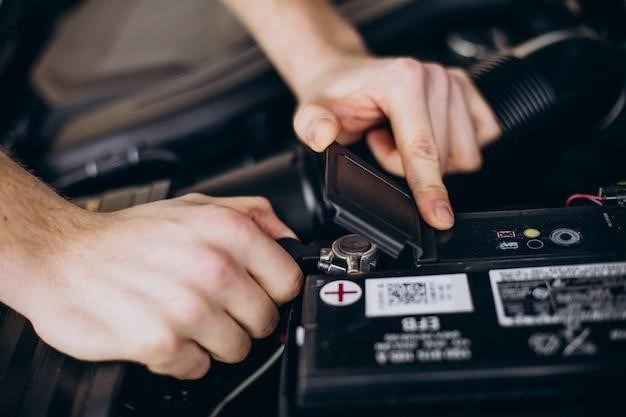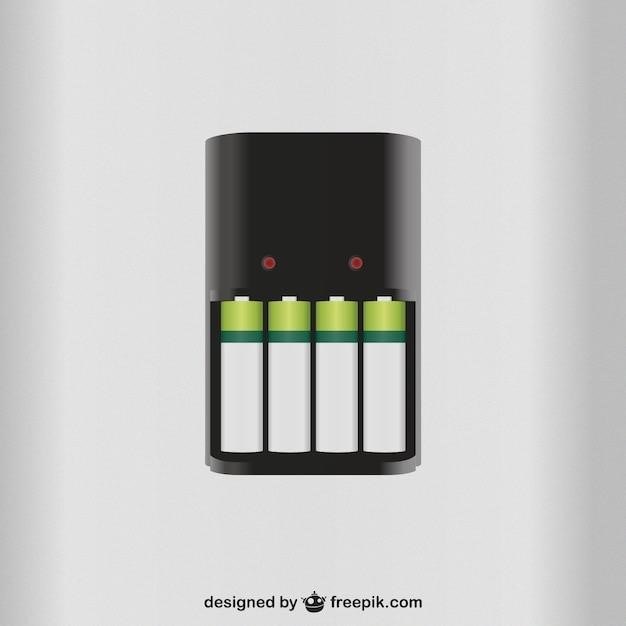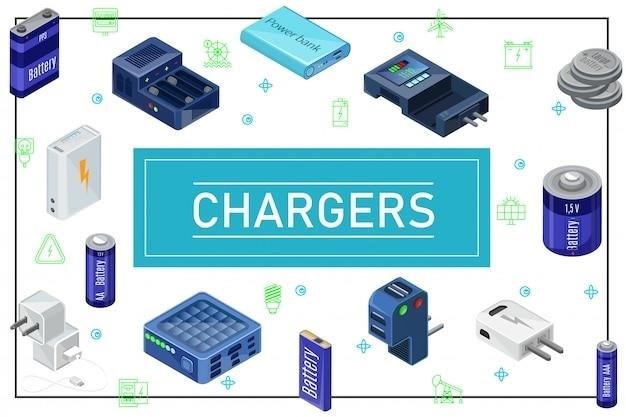die hard battery charger instruction manual

die hard battery charger instruction manual
DieHard Battery Charger Instruction Manual⁚ A Comprehensive Guide
This manual provides a complete guide to using your DieHard battery charger, covering various models like the 6/2 AMP and DH-200M. Learn about safety, connection procedures, charge rate selection, troubleshooting, and maintenance for optimal battery care and extended charger lifespan.
Understanding Your DieHard Battery Charger Model
DieHard offers a range of battery chargers, each designed for specific needs. Understanding your model is crucial for safe and effective use. Key features to identify include amperage ratings (e.g., 6/2 AMP, 10/2 AMP, 50/15/2 AMP), charging modes (manual or automatic), and additional functionalities such as engine starting capabilities or built-in battery testers. The model number, typically found on a label on the charger itself, is essential for accessing the correct instruction manual and warranty information. Manual chargers require user selection of charge rate and monitoring, while automatic chargers adjust settings based on battery condition. Some models feature a trickle charge setting for long-term maintenance, while others offer multiple amperage settings for various battery sizes and conditions. Knowing the specifications of your DieHard charger ensures you use it correctly and avoid potential damage to the charger or the battery. Consult your specific model’s manual for detailed instructions and safety precautions.
DieHard Charger Models⁚ A Comparison of Features and Specifications
DieHard produces a variety of battery chargers catering to different needs and battery types. Models like the 6/2 AMP manual charger are ideal for smaller batteries in lawnmowers or motorcycles, offering a 2-amp trickle charge for maintenance. Conversely, the DH-200M boasts a powerful 200-amp boost for jump-starting vehicles, alongside lower amperage settings for charging. Other models offer a range of amperage options (e.g., 10/2 AMP, 50/15/2 AMP) allowing for flexibility based on battery size and discharge level. Automatic models, like those with microprocessor control, simplify the charging process by automatically adjusting settings based on battery condition. These often include features such as float-mode monitoring for maintaining a full charge. Manual models provide more control but require user monitoring. Some advanced models integrate additional functionalities, such as built-in battery testers or engine starters, enhancing their versatility. Before purchasing or using a DieHard charger, carefully compare features and specifications to select the best model for your specific application and battery type. Always refer to the individual model’s manual for detailed instructions and safety precautions.
Safety Precautions⁚ Essential Guidelines Before Use
Before operating any DieHard battery charger, prioritize safety by carefully reviewing the provided instruction manual. Always wear appropriate eye and clothing protection to prevent acid splashes or other potential hazards during operation. Ensure adequate ventilation in the charging area, as lead-acid batteries generate explosive gases during use and charging. Avoid sparks or open flames near the battery to minimize the risk of ignition. Never attempt to charge a frozen battery, as this can lead to damage to the battery and charger. Connect the charger clamps securely to the battery terminals, ensuring correct polarity (+ to +, ⎻ to -). Incorrect polarity can cause damage to the battery, charger, or even personal injury. When working with a battery in a vehicle, disconnect the negative terminal first to prevent electrical shorts. Keep children and pets away from the charging area. Never leave the charger unattended while in operation. After charging, disconnect the clamps in the reverse order (negative first). If you encounter any unusual behavior, such as overheating, unusual smells, or sparking, immediately disconnect the charger and consult the troubleshooting section of your manual before attempting further use. Regularly inspect the charger’s cords and clamps for any signs of damage before each use. Replace damaged components promptly to prevent electrical hazards. Always follow all safety guidelines outlined in your specific DieHard battery charger’s instruction manual.
Preparing Your Battery for Charging⁚ A Step-by-Step Process
Before initiating the charging process, inspect the battery for any signs of damage, such as cracks, corrosion, or leaks. If any damage is present, do not attempt to charge the battery; instead, replace it with a new one. Clean the battery terminals thoroughly using a wire brush or terminal cleaner to remove any corrosion or buildup. This will ensure a proper connection and efficient charging. If the battery is located in a vehicle, consider removing it for charging if possible. This minimizes the risk of accidental short circuits and makes the connection process easier. Check the electrolyte level (if applicable) in the battery cells and add distilled water if necessary to bring the level up to the manufacturer’s recommended level. Never use tap water, as it contains impurities that can harm the battery. Before connecting the charger clamps, ensure that the battery is properly ventilated to prevent the buildup of explosive gases. If the battery is excessively hot, allow it to cool down before charging to prevent damage. Once the battery terminals are clean and the electrolyte level is correct, and the battery has cooled down if necessary, you can proceed to connect the charger. Remember to always consult your specific DieHard battery charger’s manual for detailed instructions specific to your model. Pay close attention to any warnings or specific steps provided.
Connecting the Charger⁚ Correct Polarity and Clamp Usage
Connecting the DieHard charger correctly is crucial to prevent damage to the battery and the charger itself. Begin by identifying the positive (+) and negative (-) terminals on your battery. These are usually clearly marked. The positive terminal is typically larger. Next, locate the corresponding red (+) and black (-) clamps on your DieHard charger. The red clamp connects to the positive (+) battery terminal and the black clamp to the negative (-) terminal. Always ensure a secure connection by firmly clamping each clamp onto its respective terminal. Avoid loose connections, as these can lead to arcing, sparking, or inefficient charging. If corrosion is present on the terminals, clean them thoroughly before connecting the clamps to ensure a good electrical contact. After cleaning, ensure the terminals are dry before connecting the clamps. Once the clamps are securely attached, check for any loose wires or connections on the charger itself. Inspect the clamps for any damage or wear before use. Damaged clamps should be replaced immediately to prevent accidents. Before plugging in the charger, ensure that the battery is well ventilated to prevent the buildup of explosive gases. Always follow the specific instructions in your DieHard charger’s manual, as some models may have unique connection procedures or safety precautions. Remember, proper connection is essential for safe and efficient battery charging.
Selecting the Appropriate Charge Rate and Mode
Choosing the correct charge rate and mode for your DieHard battery charger is critical for optimal battery charging and longevity. DieHard chargers often offer multiple amperage settings (e.g., 2A, 6A, 10A, etc.) and charging modes (e.g., trickle charge, fast charge, automatic). Refer to your specific charger’s manual for a detailed explanation of each setting. The amperage setting determines the rate of charge, with higher amperage leading to faster charging. However, using too high an amperage can damage the battery. Select an amperage appropriate for your battery’s capacity and condition. Consult your battery’s specifications or the DieHard manual for guidance. If unsure, always err on the side of caution and choose a lower amperage setting. Charging modes cater to different battery conditions. A trickle charge mode provides a low and steady current, ideal for maintaining a fully charged battery or charging a deeply discharged battery slowly to avoid damage. A fast charge mode is suitable for quickly charging a moderately discharged battery. Automatic modes typically analyze the battery’s condition and adjust the charge rate accordingly. Ensure the selected mode matches the battery’s state and your charging needs. Incorrectly choosing a charge rate or mode can lead to overheating, overcharging, or undercharging, which can shorten the battery’s lifespan or even cause damage. Always prioritize safety and consult your DieHard charger’s user manual for detailed instructions on selecting the appropriate charge rate and mode for your specific battery and charger model.
Charging Your Battery⁚ Monitoring the Process and Indicators
Closely monitoring the charging process is crucial to ensure optimal results and prevent potential issues. DieHard battery chargers typically incorporate visual indicators, such as LEDs or a digital display, to signal the charging status. These indicators may show charging progress, voltage levels, or errors. Pay close attention to these indicators throughout the charging cycle. Some models may have a “charging” indicator that lights up when the charger is actively supplying power to the battery. Others might display the current charge level or voltage. The manual for your specific DieHard charger will detail the meaning of each indicator. Regularly check the battery’s temperature during charging. Excessive heat can indicate a problem, such as overcharging or a faulty battery. If the battery becomes excessively hot, immediately disconnect the charger and allow the battery to cool down before resuming the charging process. Never leave the charger unattended during operation, especially during the initial stages of charging. The charging time varies depending on the battery’s capacity, condition, and the selected charge rate. Consult your DieHard charger’s manual for estimated charging times. Once the charging process is complete, the charger may automatically switch to a maintenance mode (also known as float mode), which supplies a low current to keep the battery fully charged. If your model doesn’t have an automatic maintenance mode, follow the manual’s instructions to safely disconnect the charger once the battery is fully charged. By carefully observing the charger’s indicators and the battery’s temperature, you can ensure a safe and efficient charging process.

Troubleshooting Common Issues⁚ Addressing Charging Problems
Despite careful operation, you might encounter issues with your DieHard battery charger. If the charger fails to operate, first check the power connection and ensure the outlet is functioning correctly. Inspect the power cord for any damage and replace it if necessary. Verify that the battery clamps are securely connected to the battery terminals, ensuring correct polarity (+ and -). Loose connections can hinder the charging process. If the charger displays an error code or indicator light, consult your specific DieHard charger’s manual for troubleshooting guidance. The manual provides explanations for various error codes and suggests solutions. If the battery isn’t charging, even with correct connections, the battery itself may be faulty. Have it tested at an auto parts store to assess its condition. A weak or damaged battery might not accept a charge. If the charger overheats, immediately disconnect it from the power source and the battery. Allow it to cool completely before attempting to use it again. Prolonged overheating can damage the charger’s internal components. If the charger emits unusual noises or smells, discontinue use immediately. These are signs of a potential malfunction requiring professional attention. For persistent issues not resolved by the troubleshooting steps in the manual, contact DieHard customer support for assistance. They can provide further diagnostics and repair options. Remember, safety is paramount; never attempt repairs beyond your skill level.
Maintaining Your DieHard Charger⁚ Cleaning and Storage
Proper maintenance ensures your DieHard battery charger’s longevity and optimal performance. After each use, inspect the clamps for corrosion or damage. Clean them with a wire brush or sandpaper to remove any buildup. A solution of baking soda and water can also help remove corrosion. Always disconnect the charger from the power source before cleaning. Never immerse the charger in water or use harsh chemicals. Wipe down the charger’s casing with a damp cloth to remove dirt and debris. Ensure the charging cables are neatly coiled and stored to prevent damage. Avoid storing the charger in excessively hot, cold, or humid environments. Extreme temperatures can affect the charger’s internal components and reduce its lifespan. Store it in a clean, dry place away from direct sunlight. Regularly check the power cord for any signs of wear or damage. A frayed or damaged cord should be replaced immediately to prevent electrical hazards. When not in use for extended periods, it’s recommended to store the charger in its original packaging or a protective case. This helps prevent damage from dust, moisture, or accidental impacts. Proper cleaning and storage are crucial for maintaining the safety and functionality of your DieHard battery charger, ensuring it remains reliable for years to come. By following these simple steps, you can maximize the lifespan of your valuable equipment.
Warranty Information⁚ Coverage and Claim Procedures
Your DieHard battery charger is covered by a manufacturer’s warranty, the specifics of which are detailed in the separate warranty document included with your purchase. This warranty typically covers defects in materials and workmanship under normal use conditions for a specified period (often three years, but check your documentation). The warranty does not cover damage caused by misuse, neglect, accidents, unauthorized repairs, or use beyond the intended specifications. To initiate a warranty claim, carefully review the warranty terms and conditions. You will likely need to provide proof of purchase (such as your receipt or order confirmation). Retain the original packaging and any other relevant documentation. Contacting DieHard customer support is typically the first step in the claim process. Their contact information, including phone numbers and email addresses, will be found in this manual or on their website. Be prepared to describe the problem with your charger in detail and provide any requested information or photos demonstrating the defect. DieHard may require you to return the defective charger for inspection and repair or replacement. Shipping costs and any other associated fees may be the responsibility of the customer, depending on the warranty terms. Always keep a copy of all correspondence and documentation related to your warranty claim. The warranty process aims to resolve issues fairly and efficiently, ensuring you receive the support you need if your DieHard battery charger malfunctions within the warranty period. Remember to thoroughly understand the terms and conditions of your specific warranty before making a claim.

DieHard Customer Support⁚ Contact Information and Resources
Should you encounter any difficulties using your DieHard battery charger or require assistance with troubleshooting, warranty claims, or general inquiries, several resources are available to provide support. The primary avenue for customer support is typically through DieHard’s official website. Their website usually includes a comprehensive FAQ section addressing common issues, detailed instructions, and downloadable manuals for various DieHard battery charger models. You might find answers to your questions through this self-service resource before needing to contact customer service directly. If you require direct assistance, the DieHard website typically provides multiple contact options, including a customer service phone number and an email address. When contacting customer support, be prepared to provide details about your charger model number (found on a label on the unit itself), a description of the issue, and proof of purchase if necessary. Additional resources may include online forums or communities dedicated to DieHard products or automotive repair. These online platforms can provide a wealth of user experiences and potential solutions to problems you might encounter. Remember that when seeking help through online forums, it’s crucial to verify the reliability of information provided by other users. Always prioritize official DieHard customer support channels for accurate and authoritative information regarding your DieHard battery charger. By utilizing these resources effectively, you can efficiently resolve any questions or problems you may experience with your DieHard battery charger and ensure its continued optimal performance.
Frequently Asked Questions (FAQs)
This section addresses common questions regarding DieHard battery chargers. Q⁚ My charger isn’t working. What should I check? A⁚ First, ensure the charger is properly plugged into a working outlet and that the battery terminals are clean and securely connected with the correct polarity. Check the charger’s fuses or circuit breaker for any issues. If the problem persists, consult the troubleshooting section of your manual or contact DieHard customer support. Q⁚ How long does it take to charge a battery? A⁚ Charging time varies depending on the battery’s capacity and the charger’s amperage setting. Smaller batteries may charge within a few hours, while larger ones could take significantly longer. Refer to your charger’s manual for specific charging time estimates based on your battery’s AH rating. Q⁚ Can I leave the charger connected to the battery after it’s fully charged? A⁚ Some DieHard chargers feature a “float mode” or “maintenance mode” that allows you to safely leave the charger connected indefinitely. This maintains a full charge without overcharging. However, always consult your manual to determine if your specific model supports this feature. Q⁚ What type of batteries are compatible? A⁚ DieHard chargers are typically designed for lead-acid batteries commonly used in cars, motorcycles, lawnmowers, and other similar applications. Avoid using them with other battery chemistries, like alkaline or lithium-ion batteries. Consult your manual for specific compatibility details. Q⁚ My battery is severely discharged. Can I still charge it? A⁚ Yes, but proceed with caution. Start with a lower amperage setting and monitor the charging process closely for any unusual behavior. Severe discharge may indicate a deeper problem with the battery itself. Consider professional battery testing if issues persist.